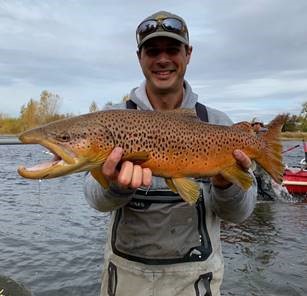Henry’s Fork, November 23rd, 2021
Snow shoes or X-country skis will help if you intend to fish the river in Island Park! Nymph patterns, large and small, and streamer patterns will be best candidates for action here and in the lower river as well.
There is near global interest in how 2021-2022 winter snowfall/water conditions will impact next season’s fishing conditions in the Henry’s Fork drainage.
Through the upcoming winter we therefore will post the Henry’s Fork Foundation’s Dr. Rob Van Kirk’s weekly summary of these conditions. Information from Dr. Van Kirk’s summary prepared on November 22nd follows.
Headlines:
- Yesterday was warm and dry, and with the exception of a little snow today and tomorrow, warm and dry conditions will continue for the next week.
- Natural flow dropped yesterday in response to a cold morning and is 78% of average.
- At a mean outflow of 119 cfs, Island Park Reservoir gained 481 ac-ft yesterday and is 66% full, compared with 61% full on average.
Details:
Despite a cold start to the day, mean temperature yesterday was 3 degrees F above average. No precipitation was recorded. Except for some light snow today and tomorrow, generally warm and dry conditions are forecast for the next week. Precipitation is tentatively forecast to return in the middle of next week.
Natural flow decreased a little yesterday as a result of cold overnight low temperatures. River icing was apparent in the Fall River hydrograph yesterday. Watershed-wide natural flow was 78% of average yesterday and within a few percentage points of that in each of the three subwatersheds. Cumulative natural flow for the water year so far is 77% of average.
At an average outflow of 119 cfs, Island Park Reservoir gained 481 ac-ft yesterday and is 66% full, compared with 61% full on average. At the current outflow, reservoir gain due to stream inflow has been in the range of 475-500 ac-ft/day. Direct precipitation on the reservoir surface has added an additional 1000 ac-ft since the start of the water year, equivalent to an additional 10 cfs of inflow, on average.
: Rob Van Kirk, Ph.D.
Senior Scientist
P.O. Box 550
Ashton, ID 83420
208-652-3567 OFFICE
208-881-3407 CELL
208-652-3568 FAX
TT

